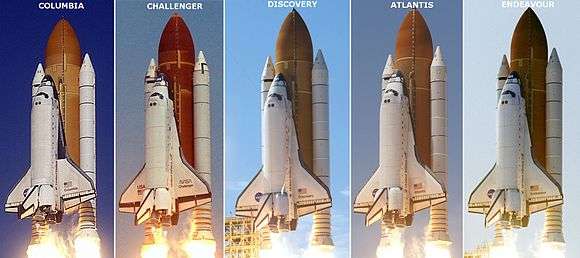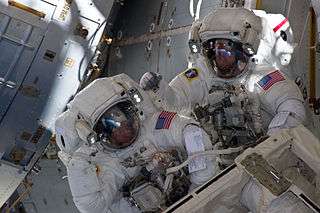List of NASA missions


This is a list of NASA missions, both manned and unmanned, since its establishment in 1958.
X-Plane program
Since 1945, NACA (NASA's predecessor) and, since 1958, NASA have conducted the X-Plane Program. The program was originally intended to create a family of experimental aircraft not intended for production beyond the limited number of each design built solely for flight research.[1] The first X-Plane, the Bell X-1, was the first rocket-powered airplane to break the sound barrier on October 14, 1947.[2] X-Planes have set numerous milestones since then, both manned and unmanned.[3]
Crewed missions



Human spaceflight
NASA has successfully launched over 100 manned flights. Two have ended in failure, causing the death of the entire crew: STS-51-L (the Challenger disaster) in 1986, and STS-107 (the Columbia disaster) in 2003. (Apollo 1 in 1967 lost three crew members but never launched.)
| Program | Start date | End date | No. of launched crewed missions |
Notes |
|---|---|---|---|---|
| Mercury program | 1959 | 1963 | 6 | First U.S. crewed program |
| Gemini program | 1963 | 1966 | 10 | Program used to practice space rendezvous and EVAs |
| Apollo program | 1961 | 1972 | 11[a] | Brought first human to the Moon |
| Skylab | 1973 | 1974 | 3 | The crewed missions only took place in 1973 and 1974; first American space station |
| Apollo-Soyuz | 1975 | 1975 | 1 | Joint with Soviet Union |
| Shuttle-Mir Program | 1995 | 1998 | 9[b] | Russian partnership |
| Project Constellation | 2003 | 2010[4] | 0 | Cancelled program to bring humans to the Moon again, to Mars and beyond |
| Space Shuttle | 1981 | 2011 | 135 | First missions in which a spacecraft was reused |
| International Space Station | 1998 | Ongoing | 44 | Joint with Russia, Canada, ESA, and JAXA along with co-operators ASI and AEB |
Notes: <div class="reflist" " style=" list-style-type: lower-alpha;">
- Apollo 1 was unlaunched due to a fire during testing that killed the astronauts, and is not counted here.
- The Shuttle-Mir missions were all Space Shuttle missions, and are also counted under the Space Shuttle program missions in the table.
Airborne observatories

Fixed wing:
| Program | Start date | End date | Aircraft |
|---|---|---|---|
| Kuiper Airborne Observatory | 1974 | 1995 | Modified Lockheed C-141A |
| Stratospheric Observatory for Infrared Astronomy (SOFIA) | 2010 | On-going | Modified Boeing 747SP |
Balloon:
| Program | Start date | End date | Aircraft |
|---|---|---|---|
| Stratoscope 2 | 1963 | 1971 | Balloon-borne 36-inch (91.4 cm) reflecting telescope |
Future
On May 7, 2009 the Obama Administration announced the launch of an independent review of planned U.S. human space flight activities with the goal of ensuring that the nation is on a vigorous and sustainable path to achieving its boldest aspirations in space. The review was conducted by a panel of experts led by Norman Augustine, the former CEO of Lockheed Martin, who served on the President’s Council of Advisers on Science and Technology under both Democrat and Republican presidents.
The "Review of United States Human Space Flight Plans" was to examine ongoing and planned National Aeronautics and Space Administration (NASA) development activities, as well as potential alternatives and present options for advancing a safe, innovative, affordable, and sustainable human space flight program in the years following Space Shuttle retirement. The panel worked closely with NASA and sought input from the United States Congress, the White House, the public, industry, and international partners as it developed its options. It presented its results on October 22, 2009.[5][6]
In February 2010, Obama announced his proposal to cancel the Constellation Program as part of the 2011 Economic Projects. Constellation was officially cancelled by the NASA Budget Authorization Act on 11 October 2010.
NASA brought the Orion MPCV back to life from the defunct Constellation Program and successfully test launched the first capsule on December 5, 2014 aboard EFT-1. After a near perfect flight traveling 3600 miles above Earth, the spacecraft was recovered for study. NASA plans to use the Orion crew vehicle to send humans to deep space locations such as the Moon, Near Earth Asteroids, and Mars starting in the 2020s. Orion will be powered by NASA's new heavy lift vehicle, the Space Launch System (SLS), which is currently under development. Orion's next flight, along with the first SLS flight, is slated to launch no later than November 2018, with the designation of Exploration Mission 1. This mission will send an uncrewed Orion capsule around the Moon. It will be succeeded by Exploration Mission 2, sending a crewed Orion spacecraft to an undetermined location in the early 2020s.
Unmanned missions
Suborbital
- Anomalous Transport Rocket Experiment (ATREX) – five consecutive launches, 80 seconds apart on March 27, 2012, studied the high-altitude jet stream .[7][8]
Earth satellites
- Gravity Recovery and Climate Experiment (GRACE)
- NPOESS Preparatory Project (NPP) – National Polar-orbiting Operational Environmental Satellite System (NPOESS)[10]
- Upper Atmosphere Research Satellite (UARS)
- Chandra X-ray Observatory
- Compton Gamma Ray Observatory
- Hubble Space Telescope – ESA partnership
- Spitzer Space Telescope (formerly known as the Space Infrared Telescope Facility, SIRTF)
- High Energy Astronomy Observatory program
- High Energy Astronomy Observatory 1 (HEAO 1)
- Einstein Observatory (HEAO 2) first fully imaging X-ray telescope
- High Energy Astronomy Observatory 3 (HEAO 3)
- Van Allen Probes – Twin probes studying the Van Allen radiation belt [12][13]
- New Millennium Program (NMP)
- Earth Observing-1 (EO-1)
- Space Technology 5 (ST5)
- Space Technology 6 (ST6)
- Far Ultraviolet Spectroscopic Explorer (FUSE)
- Kepler searching for Earth-sized exoplanets in the habitable zone
- Small Explorer program (SMEX)[14]
- Aeronomy of Ice in the Mesosphere (AIM)
- Fast Auroral Snapshot Explorer (FAST)
- Galaxy Evolution Explorer (GALEX)
- Interstellar Boundary Explorer (IBEX)
- Nuclear Spectroscopic Telescope Array (NuSTAR) – X-ray telescope orbiting Earth[15][16]
- Reuven Ramaty High Energy Solar Spectroscopic Imager (RHESSI) – Sun observing, Earth satellite
- Solar Anomalous and Magnetospheric Particle Explorer (SAMPEX)
- Submillimeter Wave Astronomy Satellite (SWAS)
- Transition Region and Coronal Explorer (TRACE) – Sun observing, Earth satellite
- Wide Field Infrared Explorer (WIRE)
- Solar Terrestrial Probes program
- Hinode (Solar-B)
- Thermosphere Ionosphere Mesosphere Energetics and Dynamics (TIMED)
- Two Wide-angle Imaging Neutral-atom Spectrometers (TWINS)
- Uhuru
- Wilkinson Microwave Anisotropy Probe (WMAP)
Lunar
- Lunar Precursor Robotic Program (LPRP)
- Lunar Prospector
- Moon Mineralogy Mapper (M3) – instrument for ISRO's Chandraayan-1
Martian
- Deep Space 2 (DS2) – (sub-surface probes)
- Mars Science Laboratory (MSL)
Asteroidal/cometary
- Deep Impact (primary) – EPOXI (extended)
- New Millennium Program (NMP)
- Deep Space 1 (DS1) – first spacecraft propelled by an Ion thruster
- Near Earth Asteroid Rendezvous - Shoemaker (NEAR Shoemaker) – close study of 433 Eros
- Origins Spectral Interpretation Resource Identification Security Regolith Explorer (OSIRIS-REx) – launched September 2016[18][19]
Other planets
- Cassini–Huygens – Saturn and its moons
- Dawn – Vesta in 2011-2012, and Ceres in 2015
- Galileo – Jupiter and its moons
- Juno – Jupiter
- Magellan (Venus Radar Mapper)
- Mariner program – Venus
- Mariner 1
- Mariner 2
- Mariner 5
- Mariner 10 – first to Mercury
- Juno Spacecraft Mission – Jupiter-bound for polar orbit in 2016[20]
- New Horizons – Pluto and its moons in 2015
- Pioneer program
- Pioneer 5 – interplanetary space between Earth and Venus
- Pioneer 6, 7, 8, and 9 – Solar wind, solar magnetic field and cosmic rays
- Pioneer 10 – first to the asteroid belt and Jupiter
- Pioneer 11 – asteroid belt and Jupiter, first to Saturn
- Pioneer Venus project
Solar
- Genesis – returned sample of solar wind
- Living With a Star
- Balloon Array for RBSP Relativistic Electron Losses (BARREL) – two campaigns of 20 balloons each, studying the Van Allen radiation belts, 2012 to 2014[21] This mission is complement to the Van Allen Probes (RBSP).[22]
- Solar Dynamics Observatory (SDO)
- Solar and Heliospheric Observatory (SOHO) – ESA partnership
- Solar Maximum Mission (SolarMax)
- Solar Terrestrial Probes program
- Magnetospheric Multiscale Mission (MMS) – launch readiness date was October 2014,[23] launched on 13 March 2015 at 02:44 UTC.[24]
- Solar TErrestrial RElations Observatory (STEREO)
- Ulysses (spacecraft) – ESA partnership
Planned missions
- InSight – Seismology and geodesy Mars lander planned for launch in 2018[25]
- Solar Probe Plus – expected to be the first mission into the Sun's corona, slated to launch in 2018[26][27]
- Origins program
- James Webb Space Telescope (JWST) – ESA partnership – launch scheduled for 2018[28][29]
Cancelled or undeveloped missions
- Comet Rendezvous Asteroid Flyby (CRAF)
- Jupiter Icy Moons Orbiter (JIMO)
- Mars Astrobiology Explorer-Cacher (MAX-C)
- Mars Telecommunications Orbiter (MTO)
- Origins program
- Pluto Kuiper Express (PLUTOKE) – replaced by New Horizons
Old proposals
- Mars Scout program
- Aerial Regional-scale Environmental Survey (ARES) (2000-10 concept)
- TAU (spacecraft)- probe to 1000 AU (1980s concept)
See also
- Space exploration
- Timeline of Solar System exploration
- When We Left Earth: The NASA Missions – 2008 documentary covering NASA's mission history.
References
- ↑ "Dryden Historic Aircraft - X-planes overview". Dryden Flight Research Center. NASA. Retrieved 2012-06-01.
- ↑ "Bell X-1 "Glamorous Glennis"". Milestones of Flight. National Air and Space Museum. Retrieved 2012-06-01.
- ↑ "APPENDIX A; HISTORY OF THE X-PLANE PROGRAM". Draft X-33 Environmental Impact Statement. NASA. Retrieved 2012-06-01.
- ↑ http://www.spacenews.com/civil/100930-house-gives-final-approval-nasa-authorization-act.html
- ↑ OSTP Press Release Announcing Review (pdf, 50k)
- ↑ "No to NASA: Augustine Commission Wants to More Boldly Go". Retrieved 2015-07-14.
- ↑ "Anomalous Transport Rocket Experiment (ATREX)". NASA. Retrieved 2012-03-15.
- ↑ "ATREX Launch Sequence" (PDF). NASA. Retrieved 2012-03-15.
- ↑ http://science.nasa.gov/earth-science/missions/
- ↑ "NPP Launch Information". NASA. Retrieved 2011-07-16.
- ↑ Landsat Missions Timeline
- ↑ "RBSP Mission Overview". NASA. Retrieved 2012-08-31.
- ↑ "RBSP". NASA/APL. Retrieved 2012-08-31.
- ↑ "Explorer Missions". NASA. Retrieved 2011-11-26.
- ↑ Clark, Stephen (2012-04-03). "Launch of NASA X-ray telescope targeted for June". Spaceflight Now. Retrieved 2012-05-15.
- ↑ "NuSTAR". NASA. 2012-06-05. Retrieved 2012-06-14.
- ↑ "GRAIL Mission: Fact Sheet". MoonKAM.UCSD.edu. Retrieved 2011-04-25.
- ↑ "NASA To Launch New Science Mission To Asteroid In 2016". NASA. Retrieved 2011-08-25.
- ↑ "NASA's OSIRIS-REx Speeds Toward Asteroid Rendezvous". NASA. Retrieved 2016-11-21.
- ↑ "Juno Mission to Jupiter" (PDF). NASA. April 2009. p. 2. Retrieved April 5, 2011.
- ↑ Karen C. Fox (2011-02-22). "Launching Balloons in Antarctica". NASA. Retrieved 2012-09-06.
- ↑ "Van Allen Probes: NASA Renames Radiation Belt Mission to Honor Pioneering Scientist". Reuters. Science Daily. 11 November 2012. Retrieved 2012-11-12.
- ↑ "STP Missions". NASA. Retrieved 2011-09-06.
- ↑ "MMS Launch". NASA.
- ↑ "NASA Targets May 2018 for Launch of Mars InSight Mission". NASA. Retrieved 2016-05-13.
- ↑ "NASA Selects Science Investigations for Solar Probe Plus". NASA. Retrieved 2012-08-31.
- ↑ "Johns Hopkins APL Team Developing Solar Probe Plus for Closest-Ever Flights Past the Sun". JHU APL. Retrieved 2012-08-31.
- ↑ "JWST Home Page". NASA. Retrieved 2011-04-25.
- ↑ "10-Year Plan for Astrophysics Takes JWST Cost into Account". SpaceNews.com. 2010-08-20. Retrieved 2011-04-25.
